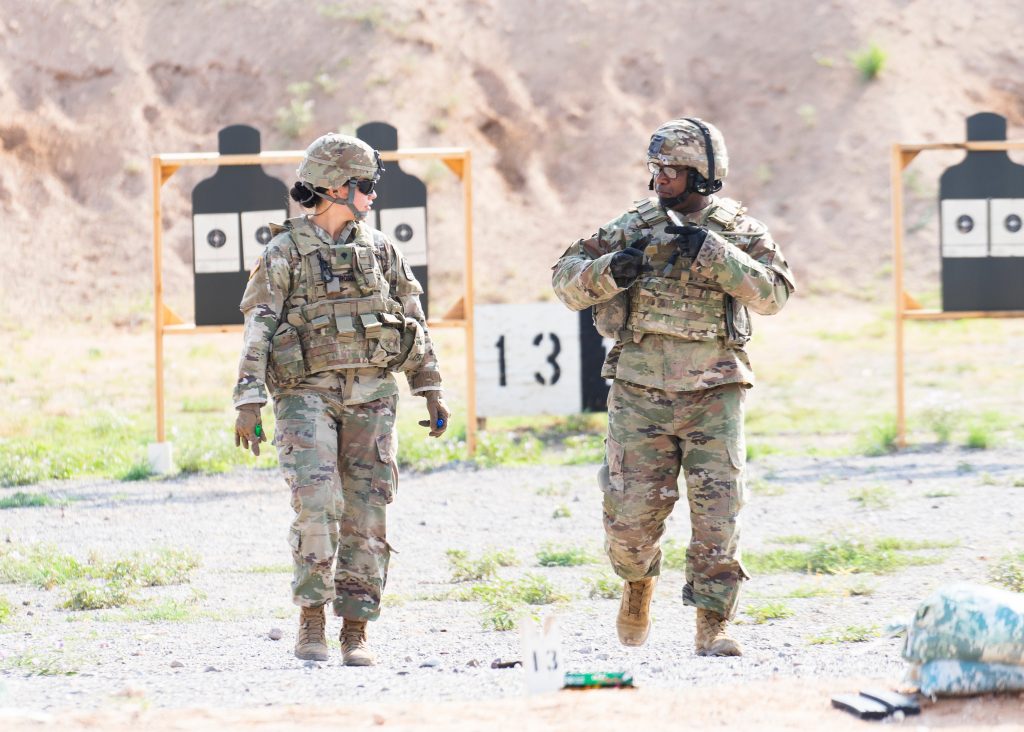Despite the success of women in the military, they still face a glass ceiling.

By Kate Bezrukova, Natalia Kalmykova and Chester Spell

Wars are certainly fought differently now than 100 years ago. Yet, while the tools, weapons, and strategies are different, people still think about war as something that engages men primarily, despite the growing presence of women in militaries across the globe. These “sticky” attitudes are slow to change partly because they have been widely held for so long. From antiquity, men were seen as hunters and warriors, and women raised children and did household duties.
These beliefs of ancient origin about men as superior fighters are entrenched in many aspects of society and cultures but are especially a part of the military culture. The notion that physical strength and size are prerequisites to effective fighting persists. And these beliefs shouldn’t surprise us; after all, numerous research studies are showing taller people (more likely men) are still more likely to get leadership positions, earn more money, and so forth (Judge & Cable, 2004).
While our biases are slow to change, war technology is changing dramatically. Artillery systems, aircraft, and drones make war longer-distance, yet in many ways more dangerous for military personnel and civilians.
Along with these technological changes, the gender makeup of the military has also been changing. Multiple nations are making substantial efforts to ensure women have the opportunity to serve and build careers in the military. The UN Resolution 1325, “Women. Peace. Security,” signed on 31 October 2000, legitimized the diversification of military employment and endorsed including more women in units.
It appears that wars can also accelerate changing gender makeup by necessity. We have seen more women fighting in Ukraine since 2014 when Russian aggression started. The percentage of women in the Armed Forces increased from 6.5 percent in 2014 to up to 15.6 percent in 2021. The full-scale invasion further accelerated the process and motivated more women to join the army to protect their country. By 2023 over 40,000 women were on active duty and over 5,000 in combat operations.
However, even with the growing number of women serving, few have reached the top ranks, which remains the case in the defense forces of several countries. In the Ukraine armed forces, only 8.9 percent of officers are women, and none are in top military combat positions. Looking at female leadership in the U.S. military, of 234,634 active duty officers, 18.9 percent are female. But again, females are disproportionately in lower ranks. There are 71 female officers of high rank, compared to 833 equivalently high-rank positions occupied by men–or 7.8 percent of the total high rank are female. (U.S. Department of Defense, 2020). A very similar situation is found in the army of Israel; among junior officers, 56 percent are women, but only 14 percent are on the level of major to colonel.
Military leadership is changing the norms behind these disparities, often meeting resistance. Yet, changes in gender composition are indeed occurring and can effectively counteract existing gender stereotypes. For example, Sasson‐Levy and Amram‐Katz (2007) and Ben-Shalom et al. (2019) showed that after four years of common service, male and female cadets expressed indifference toward the integration of men with women, perceiving it as something natural and accepting the mixed-gender service as a given fact rather than a topic to be complained about or remarked upon.
There is a more compelling rationale for the goal of gender-based equity in the military than fairness alone. Women also make unique contributions to military operations like taking better care of equipment and tools, working more carefully on tasks, keeping their areas cleaner and better organized, showing advantages in the cognitive and emotional areas, having higher mental aptitude scores, and just better understanding the men’s perspectives and tendencies. Logically, they should be as qualified to lead male teams as men, if not better.
Despite all the data pointing to women’s unique contributions to the military, they still face a glass ceiling when it comes to promoting male and female leaders in the military. Females face their first structural barrier at the rank of major. Another glass ceiling appears upon reaching the brigadier general. As in other professions and occupations, challenges include marriage and having a family, often presenting difficult decisions for women with the goal of achieving senior ranks.
Taking stock of the gender equity issue in the military reveals at least two stereotypes at play. One is the stereotype that women can not fight. Another is that women can not lead. The first has been easier to overcome, whereas the second is more resistant to progress.
Could military-based gender inequity be fixed? Optimistically, over time more and more women will achieve leadership roles in the military. The road will not be easy, as we see in other male-dominated career fields for women.
As a first step, diversity in many armed forces has already increased at the lower levels, as we showed, providing good experiences in serving together within the military. As a promotion to higher ranks becomes more commonplace, these changes should enrich the military with female managerial capabilities adding competitive advantages, particularly to those military organizations that will do this first.
On an optimistic note, while increased opportunities and gender equity in the military would seem a laudable goal, achieving it may have even more fundamental benefits. Could we dare to hope that such equity, in bringing perhaps more collaborative approaches to conflict resolution, might result in avoiding some wars? Making “wars of choice” and similar occurrences less common would make gender equity, especially at the highest level of decision-making, all the more worthwhile and a goal to be strived for.
This article was first published by Psychology Today.
Kate Bezrukova, PhD, is chair and associate professor of organization and human resources in the University at Buffalo School of Management. She is an expert on team chemistry, managing a diverse workforce, negotiations and gender, and conflict management. Her research examines group faultlines, diversity, and conflict evolution and management.
Nataliia Kalmykova is a visiting Fulbright scholar and CEO of the Ukrainian Veterans Foundation.
